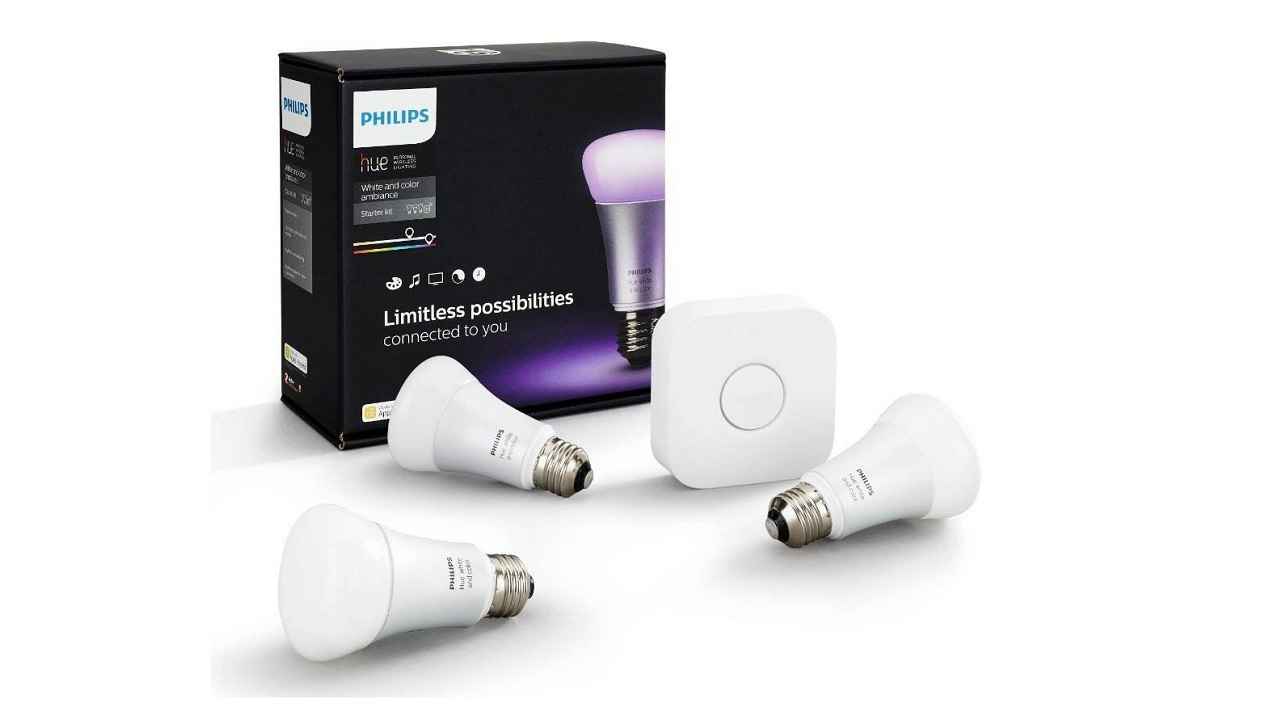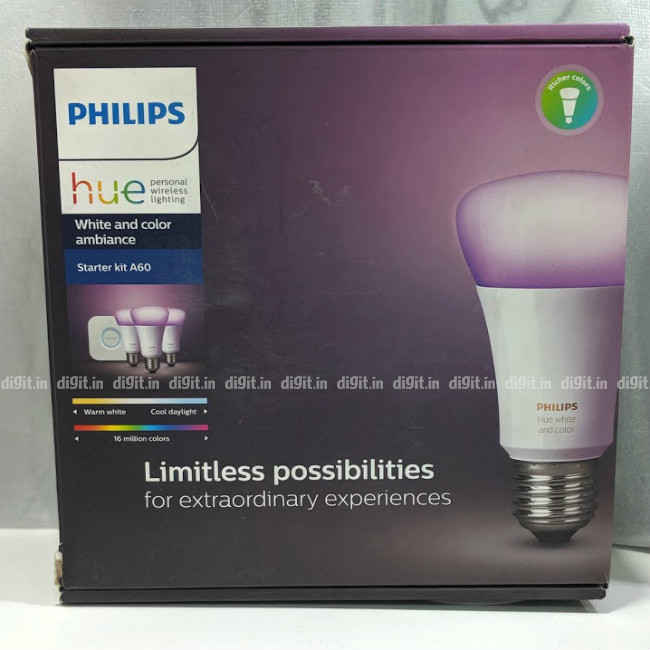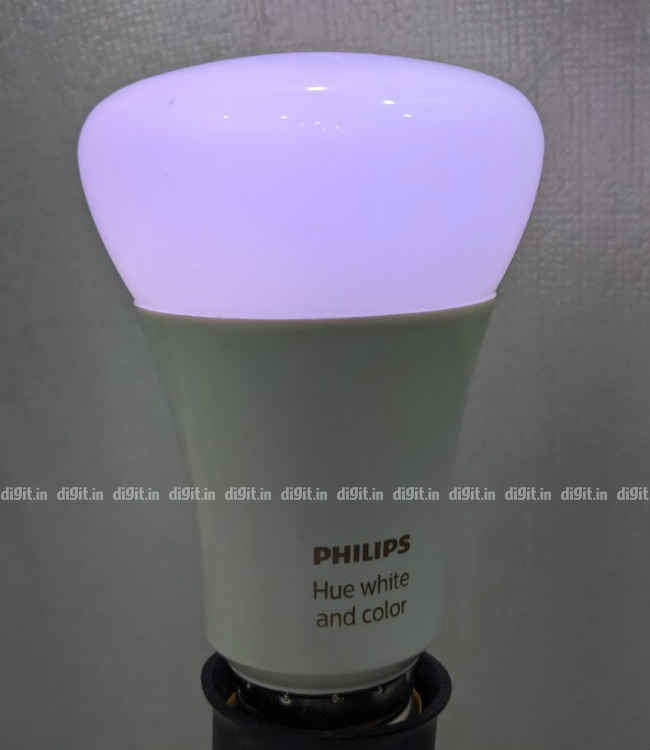Philips Hue Starter Kit A60 Review: Colours at a price

Read our review of the Philips Hue Starter Kit A60.
The Philips Hue has been around in the market and evolving gradually since late 2012. The wirelessly controlled combination of light bulbs using a hub has seen three generations of improvements and upgrades so far. The newest set to visit the Digit Test Labs is the Philips Hue Starter Kit A60, which has a price tag of Rs 17,995. It's worth noting that Philips Hue bulbs generally support one of the following ranges: white, white ambiance, white and colour ambiance.
Our review kit included a hub, which Philips likes to call Hue Bridge, and three 10W LCT010 LED light bulbs. In addition, an ethernet cable and power adaptor for the hub was bundled with the kit. The three bulbs were of the white and colour ambiance range. They were each dimmable and rated for 16 million colours and temperatures between 2,000 kelvins and 6,500 kelvins. They were each rated for 806 lumens, 25,000 hours of operation, and 50,000 on/off cycles.
Setup
Setting up the Philips Hue Starter Kit A60 was easier than I anticipated. All I had to do was connect the Hue Bridge to my home Wi-Fi router using the bundled ethernet cable and power it up. Because all the bulb holders at home supported the standard B22d (bayonet) mount and the bulbs in the kit were E27 (the screw mount), I had to get converters from a local electrical store. Just so you know, Philips also sells such bulbs separately (of both mounts) on Amazon.in and other stores for around Rs 2,799 apiece, in case you feel like adding to your kit. Because these three bulbs could operate at variable wattages, I was at liberty to place them just about anywhere—even under the bed for some mood lighting (using an extension cord, of course).
With the bulbs fitted and powered on, I downloaded the Philips Hue app on my iPhone from the App Store and fired it up. Using the simple on-screen options, I was able to search for and find the connected bulbs. Then, the app asked me to walk up to the nearby Hue Bridge and press the only button on the square device. This Push-link feature, as Philips likes to call it, is similar to the WPS protocol for Wi-Fi connections.
Soon, I was in control of all my three bulbs. All three bulbs bundled in the kit appeared under one ‘room’ in the Philips Hue app regardless of whether they were all turned on or off. I was able to rename the room “Bedroom”. After that, I was able to assign each of the three bulbs a name of my choice, like “Corner light” or “Ceiling light”. During the renaming process, the bulb being renamed would blink once to help me identify it, which I thought was a nice, helpful touch.
On the box, Philips mentions support only for Amazon Alexa and Apple HomeKit. But I was able to get it working with Google Assistant on my Google Nest Hub anyway. I did this by launching the Google Home app on my iPhone and selecting Add and manage > Set up device > Set up new devices. When the app said it had found the nearby Hue Bridge, I was asked to walk up to it and press the only button on the square white hub so the app could connect to it securely.
Operation
Asking my Google Nest Hub then to “turn off my bedroom lights” would result in all three bulbs going off all at once. On the other hand, saying, “turn off corner light in my bedroom” would result in only that specific light going off. Controlling the bulbs using just my voice was a whole lot simpler than I had imagined. My Google Nest Hub’s display even showed me controls to adjust the brightness and colour of the bulbs. Google’s connection with Philips Hue displayed an amazingly low level of latency. The bulbs would react within a second of me delivering the voice command. That’s top marks for responsiveness.
Getting the Philips kit to work with my iPhone was even simpler. I first asked Siri to turn on my bedroom lights. When it failed to find any, it suggested I set up the HomeKit connection in the Philips Hue app. During the setup, I had to walk up to the Hue Bridge again to scan a unique identification code. Soon enough, I was able to control my bulbs using Siri on my iPhone as well. On the other hand, getting the Amazon Alexa app to work with the Philips Hue wasn’t as simple because of the slightly lengthy process. I had to first enable the skill to get the bulbs connected.
Summary
I could get the three bulbs to change colour and temperature whenever I wanted, using touch or voice as long as the Hue Bridge’s connection to my home Wi-Fi router stayed intact. The Philips Hue app offered me preset ‘scenes’ such as “Savanna sunset” and “Arctic aurora”, which helped me decide what my mood was much quicker The whole Philips Hue experience was a pleasant one on the whole. If anything, I wish the entire kit wasn’t so expensive. Rs 17,995, I feel, is a heavy price to pay to get these colourful lights going when the market seems to offer cheaper options. But, for someone looking to create an automated, voice-controlled smart home, it’s probably commensurate.
I also wish the Philips Hue Starter Kit A60 came with a dedicated remote control for those who don’t always want to rely on a smartphone or smart speaker to adjust their home lighting. A neat white jog dial-equipped wireless remote control for the nightstand would not have gone amiss on a kit like this. At any rate, the Philips Hue Starter Kit A60 doesn’t fail to lighten one’s mood after a long, tiring day at work. Now, if you’ll excuse me, I’m going to set my bulbs to “Tropical twilight” and ask my Google Nest Hub to play some Kenny G.
Vignesh Giridharan
Progressively identifies more with the term ‘legacy device’ as time marches on. View Full Profile








